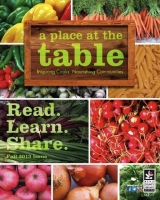A Place at the Table
King County Library System, Wash.
Innovation Synopsis
KCLS surveyed adults to identify preferences for programs and learning opportunities. Respondents named food and nutrition as top interests. With community partners, KCLS developed an interactive series on food, nutrition, and hunger that drew record participation, 18% first time attendees, and collected 30,000 pounds of food for local food banks.
Challenge/Opportunity
Staff is well aware who attends library programs and knows that simply offering the same ones will retain the same participants. But developing new programs that will attract new communities can prove challenging. What subjects will be of interest to “regulars” as well as those who’ve never attended a library program before? And how do you revitalize programs that too often resemble traditional classroom settings, with one person at the front of the room lecturing to a quiet audience? KCLS focused on developing an intentional strategy to build a broad range of System-wide adult program options that would attract new and larger audiences, especially among nontraditional groups, such as men and young people. KCLS’ 48 libraries serve a population of 1.3 million residents covering a 2,100 square mile area in western Washington. Encompassing 18 school districts, the service area includes communities with limited resources, high unemployment and frequent turnover, as well as some of the most affluent areas in the state. Understanding patron behaviors, interests and preferences would be critical in developing relevant programs that satisfy a wide range of interests and attract people who are not regular visitors to the library.
Key Elements of Innovation
KCLS convened a planning council comprised of branch staff, project planners, library managers and senior-level management. Results from a survey conducted in both English and Spanish helped the council clearly understand current patron behaviors, interests and preferences in order to create programming that is innovative in subject, design and delivery. KCLS developed a series of interactive programs that included topics such as gourmet cooking, planting vegetable gardens in small spaces, preserving food, and creating nutritious meals. Recognizing that many libraries were the only community spaces in areas of high food insecurity, the program council also incorporated educational information about hunger in our communities, and to increase engagement, added a food donation component that allowed patrons to give back to the community. Attracting program partners with ties to target communities became an essential piece of the plan and KCLS collaborated with local food banks to distribute over 30,000 pounds of food that was collected over the course of the series.
Achieved Outcomes
Starting in the spring and lasting through the end of the year, programs rotated seasonally, each with their own full-color catalog printed in house. KCLS offered 220 programs and events designed to engage and inspire adults to learn about food and develop a more conscious approach to nutrition. The year-long promotion was comprehensive, incorporating collection and online resources, workshops on nutritious meals, interactive sessions on home gardening, canning and preserving food, and exploring healthy meal options for even the busiest days. Each library offered special activities and events tailored to their community’s interests and needs, featuring ethnic foods and the connections between food, culture, and art. Collectively, program series drew more than 4,350 participants, including nearly 800 first-time attendees. In addition to increased program participation, A Place at the Table offered enduring lessons that are shaping future adult program plans. Library staff embraced the opportunity to develop interactive programs and customize offerings to community interests. A centrally-promoted, year-long program enabled a full year of branded promotion across the county, combining marketing, public relations, and advertising efforts into a highly visible unified campaign. Partnerships with eight community organizations (food banks, grocery stores and Starbucks) increased visibility, and special outreach to local culinary schools targeted new audiences with a high interest in the subject. Perhaps the greatest surprise was the success of the food bank partnerships. Through food donation boxes in each library, patrons contributed more than 30,000 pounds of food, which provided an estimated 20,538 nutritious meals for neighbors in need.

